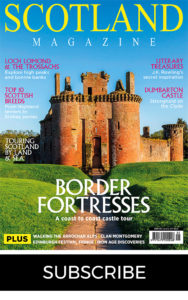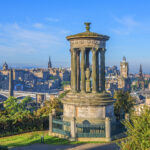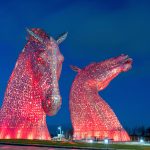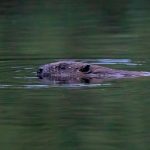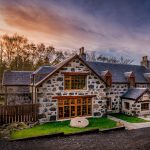MORE FROM SCOTLAND MAGAZINE
Megan Eaves goes in search of munros and starlight on the Knoydart Peninsula, but discovers a community spirit that burns brighter still
I’m on my way to Knoydart Peninsula to swap social distancing in London for total isolation among Knoydart’s wanly lit days and sparkling starlit nights.
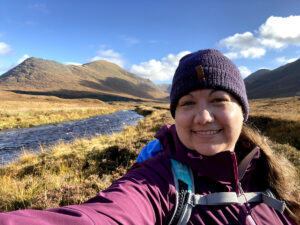
Knoydart is essentially off the grid and not a simple place to reach. Just under 200 square miles of untouched Highland backcountry, apart from forest tracks, the whole peninsula is completely transport-free. It is not connected to the mainland road or rail network, nor to the National Grid. Its power is supplied by a community-owned hydro-electric dam; water comes from a large stream called the Millburn and is collected into drums and run through UV filters at each property. There are no streetlights and no mobile signal. Little wonder Knoydart has been called ‘Britain’s last wilderness’.
Getting here requires real effort. After many trains, I reach Mallaig where a small ferry crosses the slate-grey waters of the Sound of Sleat and Loch Nevis to Inverie, the peninsula’s main settlement – a white-stone village of around 120 full-time residents and Britain’s most remote pub. The only other way to get here is by taking a gruelling 16-mile (26km) hike over the uninhabited wilderness known as the Rough Bounds. The main starting point for this trek is at Glenfinnan, where the railway passes over the curved viaduct famed for its role in the Harry Potter films.
Knoydart’s history is inextricably linked with the whole history of Scotland. At its peak in the 1740s, Knoydart was home to nearly a thousand people, mainly crofters and farmers. In 1853, most of Knoydart’s populace was sent to Canada by ships, as part of the infamous Highland Clearances, which saw the forced eviction of thousands of people from the Highlands and western islands of Scotland. However, several families refused to leave, kick-starting more than a century of struggle over Knoydart, during which time the peninsula was owned by numerous landlords.
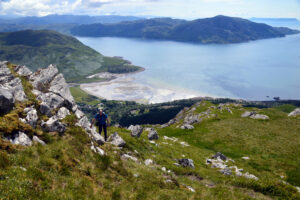
After generations of difficulty, the community on Knoydart banded together and raised funds to purchase the Knoydart Estate – a large portion of the peninsula’s land. In 1997 the Knoydart Foundation was formed, and in 1999 the estate became a self-actualised, self-owned community run by a charity, the Knoydart Foundation. The foundation provides affordable housing and green energy and cultivates a sustainable tourism trade and wildlife management scheme for active reforestation of the peninsula and management of wildlife, including its deer population.
At mid-afternoon, I step off the ferry in Inverie, fresh-faced and dampened by sea spray and rain. Only two other sets of travellers were on the boat, but all of Inverie seems to be out to meet us – innkeepers greeting guests with socially distant waves; locals loading crates, boxes of food and Amazon deliveries into their trucks – the only vehicles on Knoydart, all brought in by ferry, too.
My host is Britta Bernard, owner of Knoydart River Cottage, a luxury bed and breakfast that sits under the shadow of the corbett Sgùrr Coire Choinnichean, along the banks of the fast-running Inverie River.
While the rest of the world was devastated by COVID-19, Knoydart’s remoteness left it relatively untouched by the pandemic. At the time of my trip, the virus had not reached the peninsula and the locals wanted to keep it that way. So, guests were expected to walk to the cottage rather than risking air exchange in a vehicle – a fine chance to get the lay of the land. I load my rucksack into Britta’s truck, and she gives me directions.
“Just walk up the track this way, past the lodge and follow the signs for the bunkhouse. Once you see the bunkhouse, keep going a little and you’ll easily find us on the left. If you reach the river, you’ve gone too far.”
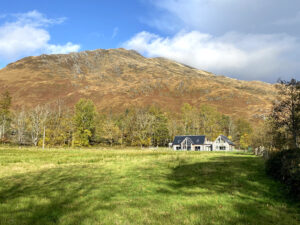
I spend six days on Knoydart, but the light changes hundreds of times. It seems to surround you and move through you and be part of you in a way that light doesn’t elsewhere. Perhaps this is because, at the end of October, the sun rises late and sets early, arcing across the southern sky for a few short hours, eking pale rays through fast-moving clouds. Here and there the light is shrouded in cloud, before offering bright blasts of light glimmering off puddles and waves. Rains wash in and out with passing breezes.
Mornings unfold slowly over cups of tea, waiting to see if drizzle will clear. Then the walk down the lane, along the river, past the bunkhouse and up the main village’s row of white cottages fronting Loch Nevis.
There is a clearing about halfway down the track that offers a perfect view across the harbour to Morar, a finger-like peninsula to the south. Sometimes the water is glassy with a grey light and thin whisps of fog brush the granite top of Morar’s highest peak, Sgùrr an Eilein Ghiubhais. Other times, there is a sharp blue canvas of sky above rollicking waves.
One morning, the rain clears, and I don my hiking boots and waterproofs and walk past the pier along a dirt track that offers passage for forest trucks and deer stalkers. It leads north towards Knoydart’s wild centre, near the peninsula’s highest munro, the 3,346-foot Ladhar Bheinn.
Along the way, a small herd of semi-wild ponies trots over to me, their long manes tangled and their bellies fat on Highland grass. The ponies are employed by deer stalkers to help transport their hunting take, but at other times are left to roam free around the Knoydart Estate.
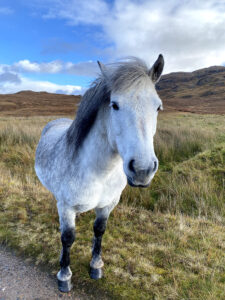
It’s a nine-mile (15km) hike to the confluence of Bheag River and a large stream called Allt Coire Torr an Asgaill, where pebbles of garnet line the riverbed. Here and there, sprays of rain mean putting my hood up and down. The only sound is the gentle whistle of the breeze against the purple-gorse-covered mountainsides, which loom in every direction.
On my visit in October 2020, there is nowhere to go in the evening, as Scotland’s pandemic rules are strict on early closures. Even still, I had hoped to visit Britain’s remotest pub, the Old Forge, a place so legendary thatpeople used to hike the Rough Bounds just to spend an evening at one of its foot-stamping music sessions. But like the sky I came in search of, the windows of the Old Forge are dark, too (though the pub has been open again since May 2021).
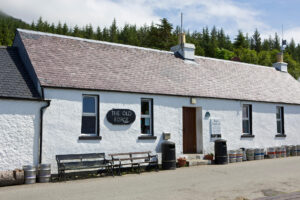
Interestingly, the pub is now up for sale, though the owners are in no rush to sell, since it is a profitable business (despite the pandemic), but there has long been a desire among locals to buy the pub and run it as a cooperative.
At the time of writing, a crowd-funding scheme was in the works to make community buy-out a possibility and if successful, the pub will be incorporated into the Knoydart Foundation.
But back to my visit. Instead of a night in the pub, I gobble down Britta’s home-cooked, local venison stew in my cosy cottage, light a fire in the wood burner, turn off the lights and wrap up in a woolly jumper to sit on the back terrace with a bottle of Knoydart Brewery porter.
Britta is passionate about protecting Knoydart’s night sky and has installed shielded, amber-coloured, dark sky-friendly lighting. All of her light fixtures point down without glare, protecting the view and the wildlife that live in the surrounding fields and forest.
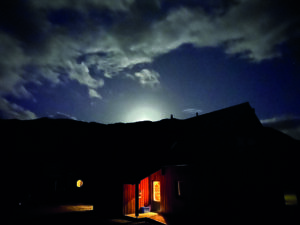
The moon is rising up the glen, casting a cool glow down the shadowy hillside. The Inverie River roars, invisible, below the house. Overhead, thousands of stars twinkle brightly and the Milky Way washes across the sky. A faint green whisper hints at aurora undulating on the northern horizon. An owl hoots, and there is rustling in the hedge nearby – nocturnal creatures going about their lives.
Under this sky, I can’t help but think of the people who were forcibly removed from these lands – their lands – and sent on ships far away. They would have looked up at these same stars, like me wrapped in woolly jumpers, warming hands over a log fire. Although Knoydart has suffered many tragedies, out of their troubled history the peninsula has cultivated a deep sense of community.
The peninsula’s story is a heart-warming example of community investment and fair management of people and nature together in a sustainable, regenerative way.
In a time of pandemic, climate apocalypse and global uncertainty, the people of Knoydart offer hope and a lesson in the value of investing in each other and protecting our world for future generations.
Since we published this piece in our November/December 2021 issue, the community in Knoydart have successfully won their bid to own The Old Forge pub.
After the pub was put on the market last year, the community held a consultation on a community buyout, with 70 members taking part. Almost all of them backed the idea, and The Old Forge Community Benefit Society (CBS) was set up. They raised more than £320,000 through a community share offer and crowdfunder, and received financial support from Scottish Land Fund and Community Ownership Fund to secure enough to buy the building and undertake essential renovations.
The committee is now preparing to relaunch the pub in a few weeks time, with the hope of opening for Easter Weekend!
Stephanie Harris, secretary of the CBS, said: “We are ecstatic that after so many months of hard work we have been successful in securing the pub for the community.” Read more about The Old Forge and the Knoydart community here.

SCOTLAND MAGAZINE
Published six times a year, every issue of Scotland showcases its stunning landscapes and natural beauty, and delves deep into Scottish history. From mysterious clans and famous Scots (both past and present), to the hidden histories of the country’s greatest castles and houses, Scotland‘s pages brim with the soul and secrets of the country.
Scotland magazine captures the spirit of this wild and wonderful nation, explores its history and heritage and recommends great places to visit, so you feel at home here, wherever you are in the world.
